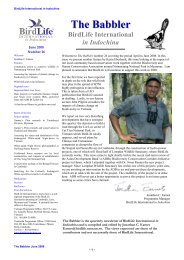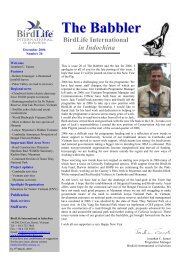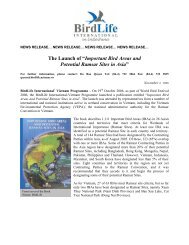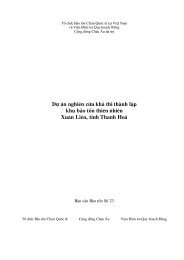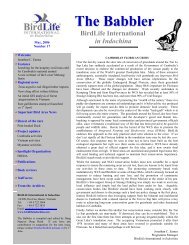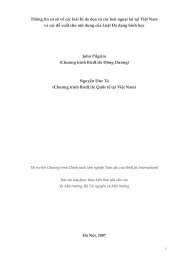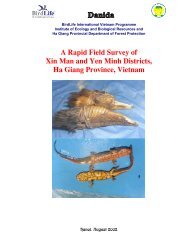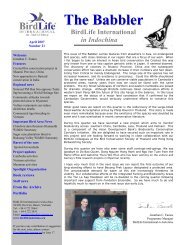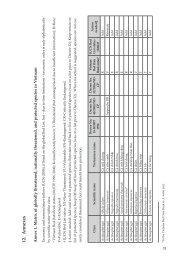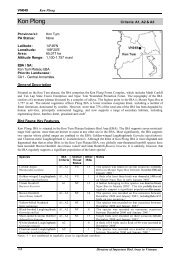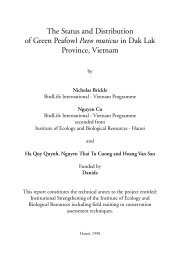Bird Life Tieng Anh-01.qxd - Birdlife International in Indochina
Bird Life Tieng Anh-01.qxd - Birdlife International in Indochina
Bird Life Tieng Anh-01.qxd - Birdlife International in Indochina
You also want an ePaper? Increase the reach of your titles
YUMPU automatically turns print PDFs into web optimized ePapers that Google loves.
6<br />
4 Site accounts<br />
This section provides a detailed description of each of the six Important <strong>Bird</strong> Areas (IBAs) assessed<br />
dur<strong>in</strong>g this project, <strong>in</strong> a sequence runn<strong>in</strong>g from north to south through the coastal Red River Delta.<br />
Follow<strong>in</strong>g an assessment of a site’s relative importance (for an explanation of how the po<strong>in</strong>ts and<br />
rank<strong>in</strong>g system was implemented, see Section 5 and Tables 1 and 2), the location and a brief<br />
description are given, followed by a summary of the status, key vegetation, socio-economic aspects,<br />
important avifauna, threats and conservation recommendations. F<strong>in</strong>ally, an assessment of changes<br />
to the site s<strong>in</strong>ce 1996 is made.<br />
4.1 An Hai<br />
Relative importance of site: Ranked 6 (6 po<strong>in</strong>ts)<br />
Prov<strong>in</strong>ce(s): Hai Phong<br />
Protected Area status: None<br />
Latitude: 20º49’N<br />
Longitude: 106º45’E<br />
Area: 5,000 ha<br />
Altitude Range: 0–2 m asl<br />
Important <strong>Bird</strong> Area (IBA): VN016<br />
General Description. The coastal zone of Hai An district, Hai Phong city, stretches 9 km from<br />
Lach Tray Estuary <strong>in</strong> the south to the Cam Estuary <strong>in</strong> the north and east. The <strong>in</strong>tertidal area <strong>in</strong> the<br />
Cam Estuary is narrow and deep but there is a wider <strong>in</strong>tertidal area <strong>in</strong> the Lach Tray Estuary and<br />
at the southern tip of the district (Pedersen and Nguyen Huy Thang 1996, Tordoff (ed.) 2002). In<br />
the mouth of the Cam River are the islands of D<strong>in</strong>h Vu and Vu Yen, both now entirely turned<br />
over to aquaculture. An <strong>in</strong>dustrial harbour was recently constructed <strong>in</strong> south-west D<strong>in</strong>h Vu, caus<strong>in</strong>g<br />
major disturbance <strong>in</strong> the Cam rivermouth for a year (Nguyen Duc Tu and Le Trong Trai 2005).<br />
North of the Cam Estuary is the large island of Dam Nha Mac, Quang N<strong>in</strong>h prov<strong>in</strong>ce, part of which<br />
is <strong>in</strong>cluded <strong>in</strong> Ha Nam IBA (VN060). It is an important w<strong>in</strong>ter<strong>in</strong>g site for waterbirds (Le Manh<br />
Hung et al. 2002). Along the entire coastl<strong>in</strong>e of Hai An District, particularly close to Lach Tray<br />
rivermouth, are many fish traps and shellfish farms. Areas <strong>in</strong>land have been converted <strong>in</strong>to<br />
aquacultural ponds for algae, shrimp and crab production. Mangrove areas have largely been removed<br />
and this habitat now only exists as small, narrow fr<strong>in</strong>ges close to rivermouths (Nguyen Duc Tu and<br />
Le Trong Trai 2005).<br />
Status. The site is currently unprotected.<br />
Vegetation. The trees <strong>in</strong> alluvial mudflats <strong>in</strong> the Cam Estuary are ma<strong>in</strong>ly Sonneratia caseolaris.<br />
In the lower layer, dense stands of Bruguiera gymnorrhiza and Aegiceras corniculatum occur along<br />
with Kandelia candel and Avicennia latana. Acanthus ilicifolius is found at high densities on marg<strong>in</strong>al<br />
alluvial coastal wetlands, and <strong>in</strong> upper alluvial sites, where B. gymnorrhiza and Aegiceras<br />
corniculatum occur. Mangrove habitat is threatened by aquacultural development, and there are tall<br />
scattered S. caseolaris trees <strong>in</strong> aquaculture ponds with some dieback tak<strong>in</strong>g place. A total of 2–3<br />
km 2 of reedbed Phragmites vallatonia occurs <strong>in</strong> aquaculture ponds and <strong>in</strong> narrow strips along dykes<br />
<strong>in</strong> the Cam Estuary. Other species <strong>in</strong>clude Casuar<strong>in</strong>a equisetifolia, Annona glabra, Premma<br />
<strong>in</strong>tergrifolia and Clerodendron <strong>in</strong>erme, with herb species and lianas (Canavalia cathartica, Derris<br />
trifoliata) along marg<strong>in</strong>al ponds. Species of Poaceae–Cynodon dactylon and Paspalum<br />
paspalodes–predom<strong>in</strong>ate along the Cam River dyke. Th<strong>in</strong>ly scattered species <strong>in</strong>clude Althernanthera<br />
sessilis, Ageratum conyzoides and Pluchea <strong>in</strong>dica, whilst scrub along dykes comprises Cyperus




